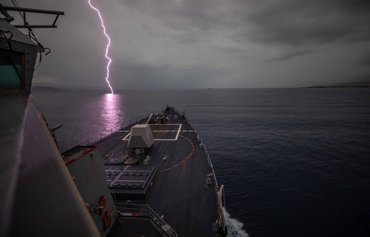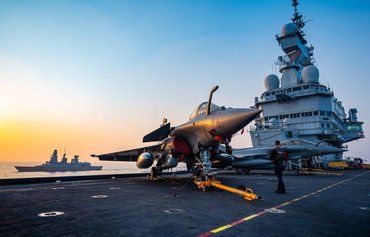The French Charles de Gaulle aircraft carrier group has teamed up with allied navies for an extended mission in the Eastern Mediterranean, with the aim of significantly increasing France's presence in military operations in the Middle East and Africa for months to come.
The Charles de Gaulle departed France on November 15 as part of Mission Antares, which involves 3,000 service members from France and allied partners.
As of December 14, the Charles de Gaulle was reporting from the Eastern Mediterranean and engaged in combat simulations as part of Operation Inherent Resolve, the international coalition mission to defeat the "Islamic State of Iraq and Syria" (ISIS).
As part of Mission Antares, the Charles de Gaulle aircraft carrier group is set to contribute to securing the eastern flank of the North Atlantic Treaty Organisation (NATO), take part in Operation Inherent Resolve and potentially set course for the Red Sea and Indian Ocean, according to a statement from the French Ministry of Armed Forces.
![Naval vessels assigned to the Charles de Gaulle carrier strike group leave port on November 15. [French Navy]](/cnmi_am/images/2022/12/15/39212-fhm22q9x0acknrt-600_384.jpg)
Naval vessels assigned to the Charles de Gaulle carrier strike group leave port on November 15. [French Navy]
![A graphic showing all the capabilities involved in the joint Mission Antares, which involves 3,000 service members from France and allied partners. [French Navy]](/cnmi_am/images/2022/12/15/39213-fhm3nofxkai84bh-600_384.jpg)
A graphic showing all the capabilities involved in the joint Mission Antares, which involves 3,000 service members from France and allied partners. [French Navy]
"The Antares mission participates in strategic posturing by maintaining a visible and assumed presence of France in maritime areas," the ministry said in a statement.
"As a leading military player, France thus demonstrates that it can intervene in its areas of interest with significant capabilities, relying on the freedom of action allowed by the high seas," it said.
Allied co-operation
The US Navy destroyer USS Roosevelt, Hellenic Navy Elli-class frigate Adrias, Italian Navy FREMM frigate Virginio Fasan and French Navy FREMM DA frigate Alsace are among the ships that the Charles de Gaulle has been seen operating alongside as part of Mission Antares.
In November, the Charles de Gaulle took part in drills involving four other NATO carriers -- the US aircraft carriers USS George H.W. Bush and USS Gerald R. Ford, the UK Royal Navy's HMS Queen Elizabeth and Italian carrier ITS Cavour.
"These operations present an opportunity for allied nations to co-ordinate critical combat power throughout the Euro-Atlantic area while showcasing NATO cohesion and interoperability," Sabrina Singh, deputy Pentagon spokeswoman, said on November 17.
"It is also an opportunity to test allied co-operation and to practice NATO's deter and defend concepts across all geographic areas, operational domains and functional areas of the alliance," Singh said.
NATO spokesperson Oana Lungescu said in a statement November 18 that the deployments "demonstrate our ability to project power across the alliance and to rapidly reinforce allies".
"These carriers deliver deterrence and they help keep our sea lines of communication open. Our strength sends a clear message that NATO will protect and defend every inch of allied territory," she said in the context of Russia's war against Ukraine.
At the NATO summit in March, allies decided to deploy carrier strike groups, submarines and significant numbers of combat ships on patrol on a persistent basis.
Commitment abroad
The deployment of the Charles de Gaulle carrier strike group to the Eastern Mediterranean and potentially the Red Sea and the Indian Ocean also represents the strong commitment of NATO countries to assist partners in the Middle East and abroad, according to military officials.
Even as NATO contends with Russia's unprovoked invasion of Ukraine, member states -- including the United States -- have been maintaining a presence in strategic areas such as the Arabian Sea.
The Arabian Sea, which sits between the Red Sea and the Indian Ocean, is the waterway that all Iranian ships must pass to reach world ports, and a key link in China's "string of pearls".
Iran has long threatened to close the Strait of Hormuz and attack maritime vessels in the event of war.
Meanwhile, China's massive infrastructure drive to connect its mainland to the Horn of Africa via a network of military and commercial facilities in recent years has raised concerns.
NATO Secretary General Jens Stoltenberg noted at the Madrid NATO summit in June that for the first time, China would figure in the alliance's new Strategic Concept.
"China is not mentioned with a single word in the current [2010] Strategic Concept. China will be part of the Concept we agree at this Summit, and I expect that allies will agree that China poses or is a challenge to our values, to our interests and to our security," he said, as quoted by a report by the US Naval Institute.
"China is not an adversary but, of course, we need to take into account the consequences to our security when we see China investing heavily in new modern military capabilities, long-range missiles, nuclear weapons, and also trying to control critical infrastructure," Stoltenberg said.

![Combat drills aboard the Charles De Gaulle aircraft carrier on December 14. [French Ministry of Armed Forces]](/cnmi_am/images/2022/12/15/39635-fj8zu6lwaaikfv2-600_384.jpg)






